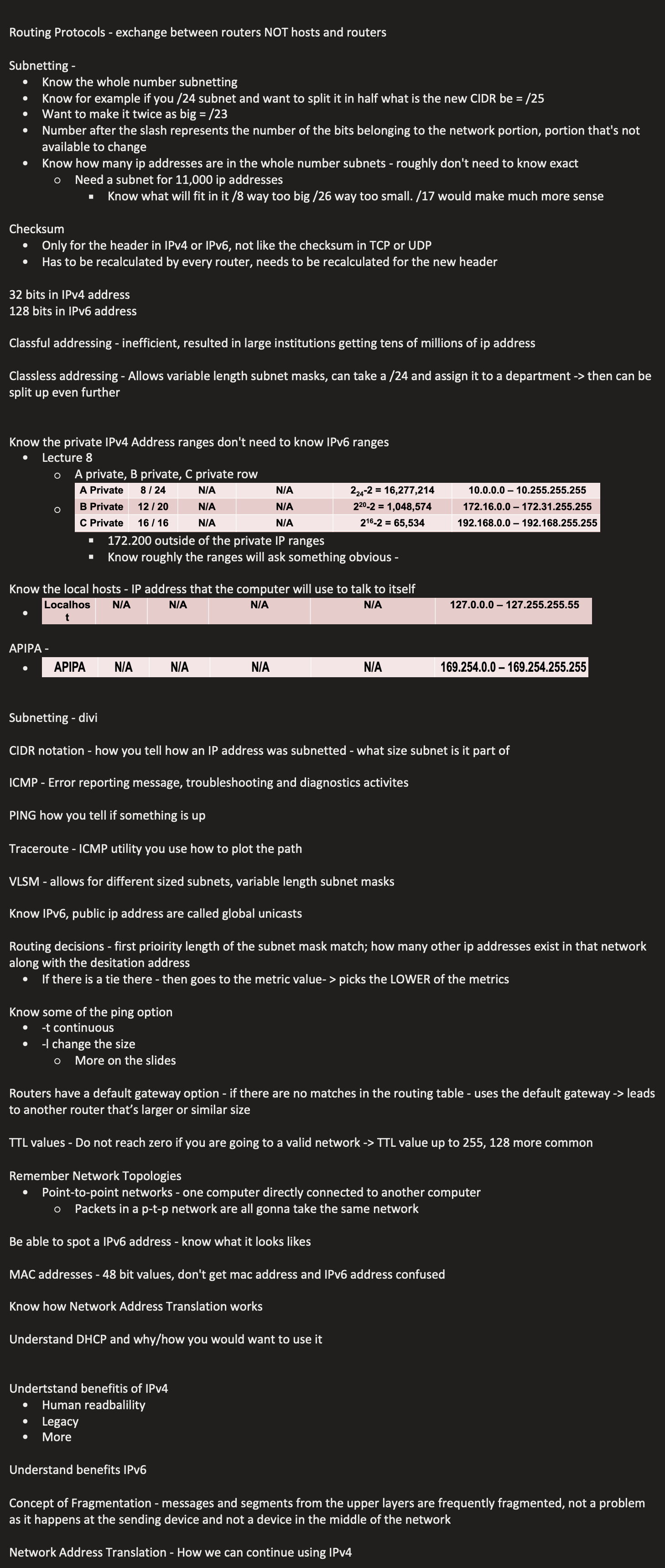IT276 Exam2
Routing Protocols - exchange between routers NOT hosts and routers
Subnetting -
Know the whole number subnetting
Know for example if you /24 subnet and want to split it in half what is the new CIDR be = /25
Want to make it twice as big = /23
Number after the slash represents the number of the bits belonging to the network portion, portion that's not available to change
Know how many ip addresses are in the whole number subnets - roughly don't need to know exact
Need a subnet for 11,000 ip addresses
Know what will fit in it /8 way too big /26 way too small. /17 would make much more sense
Checksum
Only for the header in IPv4 or IPv6, not like the checksum in TCP or UDP
Has to be recalculated by every router, needs to be recalculated for the new header
32 bits in IPv4 address
128 bits in IPv6 address
Classful addressing - inefficient, resulted in large institutions getting tens of millions of ip address
Classless addressing - Allows variable length subnet masks, can take a /24 and assign it to a department -> then can be split up even further
Know the private IPv4 Address ranges don't need to know IPv6 ranges
Lecture 8
A private, B private, C private row
172.200 outside of the private IP ranges
Know roughly the ranges will ask something obvious -
Know the local hosts - IP address that the computer will use to talk to itself
APIPA -
Subnetting - divi
CIDR notation - how you tell how an IP address was subnetted - what size subnet is it part of
ICMP - Error reporting message, troubleshooting and diagnostics activites
PING how you tell if something is up
Traceroute - ICMP utility you use how to plot the path
VLSM - allows for different sized subnets, variable length subnet masks
Know IPv6, public ip address are called global unicasts
Routing decisions - first prioirity length of the subnet mask match; how many other ip addresses exist in that network along with the desitation address
If there is a tie there - then goes to the metric value- > picks the LOWER of the metrics
Know some of the ping option
-t continuous
-l change the size
More on the slides
Routers have a default gateway option - if there are no matches in the routing table - uses the default gateway -> leads to another router that’s larger or similar size
TTL values - Do not reach zero if you are going to a valid network -> TTL value up to 255, 128 more common
Remember Network Topologies
Point-to-point networks - one computer directly connected to another computer
Packets in a p-t-p network are all gonna take the same network
Be able to spot a IPv6 address - know what it looks likes
MAC addresses - 48 bit values, don't get mac address and IPv6 address confused
Know how Network Address Translation works
Understand DHCP and why/how you would want to use it
Undertstand benefitis of IPv4
Human readbalility
Legacy
More
Understand benefits IPv6
Concept of Fragmentation - messages and segments from the upper layers are frequently fragmented, not a problem as it happens at the sending device and not a device in the middle of the network
Network Address Translation - How we can continue using IPv4
